» posted on Monday, September 26th, 2022 by Linda Lou Burton
Freddie & The Doors
Linda Lou Burton posting from Zanzibar Serena Hotel, Stone Town, Zanzibar, Tanzania –  Is this going to be a post about rock stars? Well yes, and no. Those of a certain generation might think “rock stars” when you see The Doors; likewise when you see the name Freddie. Freddie Mercury. Queen. The Doors. They were the noise of the 60s, and onward; controversial and influential, changing music and leaving behind songs that stick with us to this day. And they were flamboyant! So it was a bit of a surprise to realize our hotel was just around the corner from the Freddie Mercury museum in Stone Town, Zanzibar, a city steeped in traditions that go back to Medieval times. Freddie didn’t BECOME a rock star in this setting, but he was BORN in Stone Town on September 5, 1946, as Farrokh Bulsara to
Is this going to be a post about rock stars? Well yes, and no. Those of a certain generation might think “rock stars” when you see The Doors; likewise when you see the name Freddie. Freddie Mercury. Queen. The Doors. They were the noise of the 60s, and onward; controversial and influential, changing music and leaving behind songs that stick with us to this day. And they were flamboyant! So it was a bit of a surprise to realize our hotel was just around the corner from the Freddie Mercury museum in Stone Town, Zanzibar, a city steeped in traditions that go back to Medieval times. Freddie didn’t BECOME a rock star in this setting, but he was BORN in Stone Town on September 5, 1946, as Farrokh Bulsara to  Indian-born parents Bomi and Jer Bulsara. Bomi was a cashier at the British Colonial Office in Stone Town; Zanzibar was a British Protectorate at the time. Farrokh spent most of his school years in India, coming back to Zanzibar in 1963 to be with his parents; but in spring of 1964 the family fled to England to escape the violence of the revolution against the Sultan of Zanzibar and the mainly Arab government. Farrokh changed his name to Freddie Mercury in England and you know the rest of that story. (Or not.) The Museum was opened in Zanzibar November 24, 2019, commemorating the 28th anniversary of Freddie’s death.
Indian-born parents Bomi and Jer Bulsara. Bomi was a cashier at the British Colonial Office in Stone Town; Zanzibar was a British Protectorate at the time. Farrokh spent most of his school years in India, coming back to Zanzibar in 1963 to be with his parents; but in spring of 1964 the family fled to England to escape the violence of the revolution against the Sultan of Zanzibar and the mainly Arab government. Farrokh changed his name to Freddie Mercury in England and you know the rest of that story. (Or not.) The Museum was opened in Zanzibar November 24, 2019, commemorating the 28th anniversary of Freddie’s death.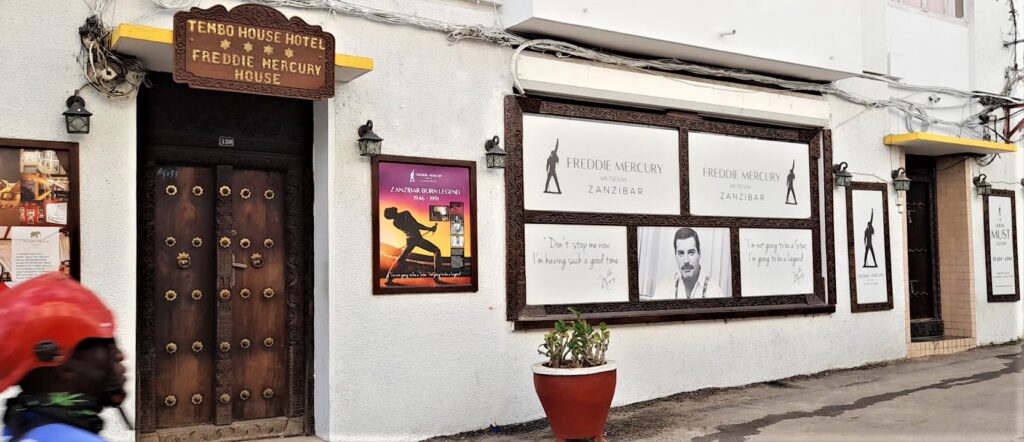
“We can walk there together later on our own,” we agreed this morning as Rick headed out to begin his organized City Walking Tour. Well, we didn’t. But Rick walked past it on his tour, and I rode past it in the tour van later. Ha! At least we both saw the beautiful DOOR out front.
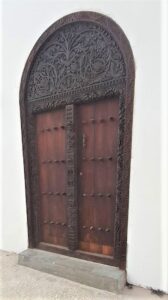 NOW TO THE DOORS: Zanzibar is FAMOUS for its DOORS! As it should be; they are elegant, intricate, beautiful, and long-lasting bits of “history we like to look at.” Fortunately, craftsmen and artists and entrepreneurs will make one for you in this day and time, for a price of course. Rick and I were just intent on looking AT them today, and thinking about events that took place on either side of them. What stories they could tell! The buildings in Stone Town are old; the streets and alleyways are narrow and crowded. We both took photos; of doors surrounded by people, cats, cars, life in a hurry or life over a cup of coffee. I give you a few descriptive bits (don’t get bored) about the meaning of the designs, see what you can pick out on the photos of the doors we saw. How old would you guess each door to be? Consider this:
NOW TO THE DOORS: Zanzibar is FAMOUS for its DOORS! As it should be; they are elegant, intricate, beautiful, and long-lasting bits of “history we like to look at.” Fortunately, craftsmen and artists and entrepreneurs will make one for you in this day and time, for a price of course. Rick and I were just intent on looking AT them today, and thinking about events that took place on either side of them. What stories they could tell! The buildings in Stone Town are old; the streets and alleyways are narrow and crowded. We both took photos; of doors surrounded by people, cats, cars, life in a hurry or life over a cup of coffee. I give you a few descriptive bits (don’t get bored) about the meaning of the designs, see what you can pick out on the photos of the doors we saw. How old would you guess each door to be? Consider this:
- The Swahili or Zanzibari doors were developed during the Middle Ages.
- The oldest are found along the East African coast from Mozambique to Kenya.
- The highest concentration of remaining doors is in Zanzibar’s Stone Town.
- They were created for the wealthy: sultans and slave traders and caravan traders.
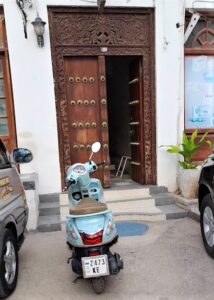 The Swahili designs are divided into two types; the classic rectangular is more geometric with more pre-Islamic forms; with motifs of lotus, rosettes, chain, date palms, and fish. Later designs changed to arched lintels; these doors have more floral patterns due to Indian inspiration as more Indian immigrants came to East Africa. The chain was replaced with beads on the frame; the fish became a vase with vines. The center of the lintel in both the rectangular and arched style usually has an Arabic inscription – a quote from the Koran, the date of completion of the door, or the owner’s initial and/or name. The doors themselves are not carved, instead, they are studded with metal tiers usually made of Brass or cast iron. The wood used for the most expensive doors is African ebony or imported teak.
The Swahili designs are divided into two types; the classic rectangular is more geometric with more pre-Islamic forms; with motifs of lotus, rosettes, chain, date palms, and fish. Later designs changed to arched lintels; these doors have more floral patterns due to Indian inspiration as more Indian immigrants came to East Africa. The chain was replaced with beads on the frame; the fish became a vase with vines. The center of the lintel in both the rectangular and arched style usually has an Arabic inscription – a quote from the Koran, the date of completion of the door, or the owner’s initial and/or name. The doors themselves are not carved, instead, they are studded with metal tiers usually made of Brass or cast iron. The wood used for the most expensive doors is African ebony or imported teak.
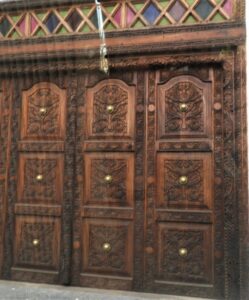
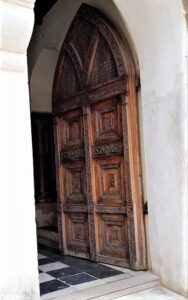
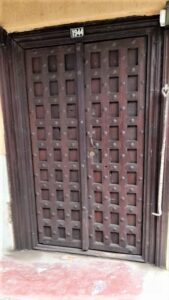

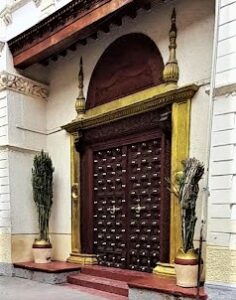
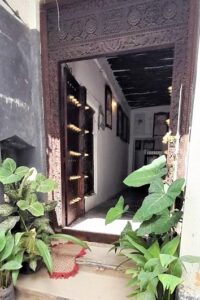
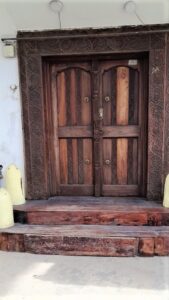
Zanzibar Serena Hotel https://www.serenahotels.com/zanzibar
Fisherman’s Tours https://fishermantours.com/
Freddie Mercury Museum https://freddiemercurymuseum.com/
Next Post: To Market, To Market
